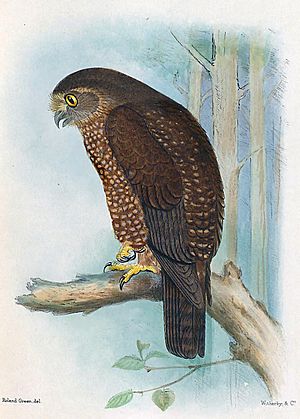Norfolk boobook facts for kids
Quick facts for kids Norfolk boobook |
|
|---|---|
 |
|
| Illustration by Henrik Grönvold | |
| Conservation status | |
| Scientific classification |
|
| Kingdom: | Animalia |
| Phylum: | Chordata |
| Class: | Aves |
| Order: | Strigiformes |
| Family: | Strigidae |
| Genus: | Ninox |
| Species: | |
| Subspecies: |
†N. n. undulata
|
| Trinomial name | |
| Ninox novaeseelandiae undulata (Latham, 1801)
|
|
The Norfolk boobook (Ninox novaeseelandiae undulata) was a special type of owl. It was also called the Norfolk Island boobook or Norfolk Island owl. This bird lived only on Norfolk Island, which is an Australian territory. Norfolk Island is in the Tasman Sea, between Australia and New Zealand.
The Norfolk boobook was a subspecies of the morepork owl. A subspecies is like a unique group within a species. Sadly, this owl is now extinct, meaning it no longer exists. The last female Norfolk boobook was seen in 1996. But its genes still live on in a small group of owls on the island today. These owls are a mix of the Norfolk boobook and another type of morepork.
Contents
About the Norfolk Boobook
The Norfolk boobook looked a lot like other morepork owls. It was a small, brown hawk owl with spotted feathers. It was smaller and darker than the Australian morepork. It also had more reddish colours and many spots.
However, it was a bit bigger than the morepork owls from New Zealand. Female boobooks were usually larger than the males. This made it tricky to tell the sex of the mixed-breed owls during conservation efforts.
Where They Lived
The Norfolk boobook lived in the island's subtropical rainforest. Sadly, much of this forest was cut down in the 1800s after people settled there. Most of the remaining forest is now part of the Norfolk Island National Park. This park is quite small, covering only about 4.65 square kilometres.
Life and Habits
Reproduction
Norfolk boobooks made their nests in tree hollows. These are natural holes found in trees. They usually laid two eggs at a time. Sometimes they laid one or three eggs.
Feeding Habits
These owls hunted for their food. They ate small animals like birds and mammals. They also ate many different kinds of insects and other small creatures.
Why They Disappeared and How We Tried to Help
The number of Norfolk boobooks went down a lot. This happened because their forest home was cleared and changed. Cutting down large trees was a big problem. These trees had the best hollows for the owls to nest in.
The owls also faced competition for nesting spots. Feral honey bees and crimson rosellas (a type of parrot) also wanted to use the tree hollows.
By 1986, only one female Norfolk boobook was left. Her name was "Miamiti." To try and save some of her genes, two male moreporks were brought to the island. These males came from New Zealand. Scientists chose them because they were closely related to the Norfolk Island boobook. Special Nest boxes were also put up for the owls.
One of the male owls disappeared a year later. But the other male successfully mated with Miamiti. They had chicks in 1989 and 1990. Miamiti, the last pure Norfolk boobook, disappeared in 1996.
By then, there was a small group of about a dozen mixed-breed owls. These owls and their children still live on Norfolk Island today. In 2011, 52 young mixed-breed owls had been tagged. By 2019, this owl population was still successfully having babies. This was amazing, especially after facing such a big challenge to survive.
- Anon. (2004). What the Environment Protection and Biodiversity Conservation Act 1999 (EPBC Act) means for Norfolk Island. Commonwealth of Australia. ISBN: 0-642-55031-X [1]
- Garnett, Stephen T.; & Crowley, Gabriel M. (2000). The Action Plan for Australian Birds 2000. Environment Australia: Canberra. ISBN: 0-642-54683-5 [2]
- Higgins, P.J. (ed). (1999). Handbook of Australian, New Zealand and Antarctic Birds. Volume 4: Parrots to Dollarbird. Oxford University Press: Melbourne. ISBN: 0-19-553071-3



